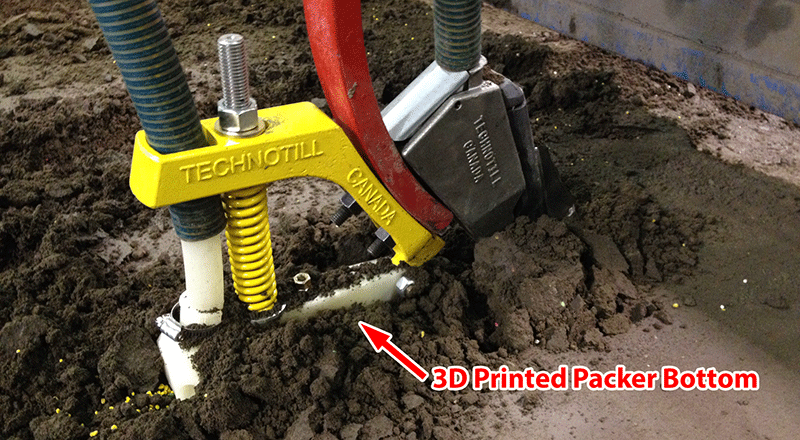3D printing for agriculture
HELPING INNOVATIVE IDEAS TAKE SHAPE
PRODUCERS HAVE ALWAYS been known for their inventiveness. If there is a quicker and easier way to complete a task, they will find it — as long as it doesn’t compromise the end result. If the tools they have at hand don’t quite do the job, they invent one that will. In the past, though, it was sometimes both difficult and costly to pursue those inventions. Today, however, it is not. Thanks to 3D printing technology, growers are free to explore those ideas in a timelier and more cost-effective way.

BACKGROUND
Invented by Chuck Hull, stereolithography, or solid imaging technology, has been around since the mid-1980s. The technology has greatly advanced since that time. Printers have become smaller and the material with which they print has improved.
How does an idea come to life using a 3D printer? Ideas must be first developed using digital modeling software. The software then creates the 3D design, which is essentially a map for the 3D printer to read. The technology is referred to as additive manufacturing, since it manufactures a solid, three-dimensional object by adding layers of material. Just how strong the end product is depends on the quality of both the printer and the substance used to create the 3D object.
Each printer differs in how it creates an object. Some spray, while others squeeze material onto a platform. The Makerbot Replicator 2, one of the most popular models, for instance, uses a renewable bioplastic which is spooled in the back of the device. Once the printer receives its instructions, the bioplastic filament is pulled into an extruder through a tube. The extruder heats up and deposits the bioplastic through a small hole onto the platform. Much like an inkjet printer, 3D printers pass over the platform making deposits each time it passes over the platform. It does this until the product is complete. Depending on the complexity of the design, it can take mere hours — or days — for the product to reach completion.
BRINGING IDEAS TO LIFE
Over the past few years, 3D-printed innovations have popped up all over the place, including in agriculture. Not all are successful, but many are.
Alex Hansen, a farmer’s son and a third-year engineering student at the University of Saskatchewan, used 3D printing technology in an attempt to design a small part. The part, a small, directional button used to control the joystick on the family combine, was broken, which made it uncomfortable to use for extended periods of time. This was especially frustrating during the long days of harvest, says Hansen.
Hansen had access to 3D modeling software and a printer at the university, and decided to attempt to redesign the part. “Printing took a few tries to get it to work, but once it printed it was good,” he says. “The plastic used in printing solidified into a hard piece that, at the time, looked perfect.”
Unfortunately, it didn’t work. “Even though it didn’t work, it was an interesting idea to try,” he said. “Given more time to try and fix the problem, I’m sure it would have been done.”
Jeremy Laliberte, associate professor at Carleton University, has been working on ways to apply drone technology in real situations for several years. Collaborating with Krissia Quesney Nevarez, a Mexican engineering student, Laliberte designed a low-cost drone to measure photosynthesis in plants. The pair used a modified action camera (similar to a GoPro) that is capable of taking images every couple of seconds.
Because of the number of sensors on the drone, the camera had to be moved off to one side. The problem, though, says Laliberte, was that it wouldn’t stay in place. At the suggestion of Nevarez, they decided to design and print a custom bracket to hold the camera in place. The design was a success, and the pair printed half a dozen brackets so that they could install more than one camera on different drones.
In early 2015, Jason Knott, CEO of Framework Animation, was approached by two of his regular clients and asked to recreate the ‘packer’ component of their Technotill Seeding System. They wanted to first test the part before deciding whether or not to recase it in iron, which can be quite costly.
“In order to create the part, I was first given one of the actual cast metal parts, which I carefully measured and replicated in my 3D modeling software,” explained Knott. “From there, we made certain modifications to understand how they might affect the characteristics of fertilizer placement.”
Using a MakerBot Replicator 3D printer, Knott printed the part in PLA plastic, a hard plastic made of cornstarch. Similar to ABS, PLA plastic is also used to make sanitary plumbing lines. PLA plastic is both non-toxic and biodegradable.
Knott had his concerns about the part, namely that it would break under the pressure of running it through the soil.
“Thankfully, it did just fine and we ran several passes through the soil bin at the Ag Tech Centre here in Lethbridge,” he said. “The part performed admirably and we were able to determine useful information about the modifications we were testing.”
Allan Cronen, CEO of GVL Polymers, a rotational molding manufacturer in Litchfield, Minnesota, purchased a 3D printer to tackle small projects similar to Knott’s. Since that time, he’s been fulfilling clients’ requests for everything from corn snouts to augers, and seed discs to closing wheels.
“All of the parts have worked out well,” said Cronen. “They have been used to test form, fit, and sometimes function.”
Often, three-dimensional printed parts from GVL Polymers are used to verify design or in field tests. Cronen has had nothing but positive experiences with 3D printing. “The only con can be the cost,” said Cronen.
The costs, though, are often outweighed by the fact that they allow end users to test the product first before paying to design an expensive mould, he said. Often, too, 3D printing technology helps bring innovations to market faster.
3D technology will continue to provide new ways for engineers to improve the products and equipment used by farmers. The only thing standing in the way of their development is that someone hasn’t thought them up yet. •






















